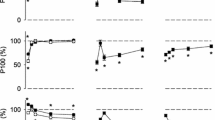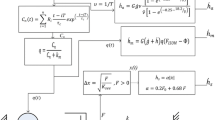Abstract
For rat medial gastrocnemius muscle economy (i.e. the ratio of time integral of force and total energy-rich phosphate consumption) was calculated. Muscles in situ at 35°C were stimulated to perform either one continuous or several repetitive isometric contractions at one muscle length in the range from 70% to 130% of optimum muscle length for force generation. Whereas during one continuous contraction economy increased, no differences in economy were found between 6, 12 or 18 successive contractions. Economy during intermittent exercise was always lower than during continuous exercise. The difference in economy is a result of different rates of metabolism, whereas no difference was found for force generation. Economy was highest at optimum muscle length for force generation and decreased at muscle lengths smaller as well as greather than optimum muscle length. Force-dependent energy consumption was calculated by substracting the force-independent part (obtained by extrapolation) from total energy consumption. The calculated force produced per μmol force-dependent energy-rich phosphate consumption was similar in muscles stretched beyond optimum length. In contrast, a decreasing amount of force per μmol force-dependent energy-rich phosphate consumption was observed at lengths smaller than optimum length.
Similar content being viewed by others
References
Aragon JJ, Tornheim K, Lowenstein JM (1980) On a possible role of IMP in the regulation of phosphorylase activity in skeletal muscle. FEBS Letters 117:suppl K 56–64
Bergmeyer HV (ed) (1970) Methoden der enzymatischen Analyse. Verlag Chemie, Weinheim
Blinks JR, Rudel R, Taylor SR (1978) Calcium transients in isolated amphibian skeletal muscle fibres: detection with aequorin. J Physiol 277:291–323
Curtin NA, Woledge RC (1978) Energy changes and muscular contraction. Physiol Rev 58:690–761
Goldspink G (1978) Energ turnover during contraction of different types of muscle. In: Asmussen E, Jorgensen C (eds) Biomechanics, VI-A Int. series on Biomechanics, vol 2B. University Park Press, Baltimore, pp 27–39
Gordon AM, Huxley AF, Julian FJ (1966a) Tension development in highly stretched vertebrate muscle fibres. J Physiol 184:143–169
Gordon AM, Huxley AF, Julian FJ (1966b) The variation in isometric tension with sarcomere length in vertebrate muscle fibres. J Physiol 184:170–192
Haan A de, van Doorn JE, Westra HG (1985a) Effects of potassium +magnesium aspartate on muscle metabolism and force development during short intensive static exercise. Int J Sports Med 6:44–49
Haan A de, van Doorn JE, Huijing PA, Woittiez RD, Westra HG (1985b) The effect of muscle length on force-time integral in relation to energy-rich phosphate consumption. In: Perren SM, Schneider E (eds) Biomechanics: current interdisciplinary research, Martinus Nijhoff Publishers, Dordrecht, pp 605–610
Herring SW, Grimm AF, Grimm BR (1984) Regulation of sarcomere number in skeletal muscle: a comparison of hypotheses. Muscle Nerve 7:161–173
Homsher E, Kean CJ (1978) Skeletal muscle energetics and metabolism. Ann Rev Physiol 40:93–131
Homsher E, Mommaerts WFHM, Ricciuti NV, Wallner A (1972) Activation heat, activation metabolism and tension-related heat in frog semitendinosus muscles. J Physiol 220:601–625
Huijing PA, Woittiez RD (1986) Length range, morphology and mechanical behaviour of rat gastrocnemius muscle during isometric contraction at the level of the muscle and muscletendon complex. Neth J Zool 35:505–515
Kushmerick MJ, Paul RJ (1977) chemical energetics in repeated contractions of frog sartorius muscles at 0°C. J Physiol 267:249–260
Marechal G, Mommaerts WFHM (1963) The metabolism of phosphocreatine during an isometric tetanus in the frog sartorius muscle. Biochim Biophys Acta 70:53–67
Rall JA (1980) Effect of previous activity on the energetics of activation in frog skeletal muscle. J Gen Physiol 75:617–631
Rall JA (1982) Energetics of Ca2+ cycling during skeletal muscle contraction. Fed Proc 41:155–160
Rome LC, Kushmerick MJ (1983) Energetics of isometric contractions as a function of muscle temperature. Am J Physiol 244:C100-C109
Sandberg JA, Carlson FD (1966) The length dependence of phosphorylcreatine hydrolysis during an isometric tetanus. Biochem Z 345:212–231
Smith ICH (1972) Energetics of activation in froc and toad muscle. J Physiol 220:583–599
Westra HG, de Haan A, van Doorn H, de Haan EJ (1982) Shortterm and persistant metabolic changes as induced by exercise. In: Addink ADF, Spronk N (eds) Exogenous and endogenous influences on metabolic and neural control. Pergamon Press, Oxford New York
Westra HG, de Haan A, van Doorn JE, de Haan EJ (1985) The effect of intensive interval training of the anaerobic power of the rat quadriceps muscle. J Sports Sci 3:139–150
Woittiez RD, Huijing PA, Rozendal RH (1983) Influence of muscle architecture on the length-force diagram in mammalian muscle. Pflügers Arch 399:275–279
Woittiez RD, Huijing PA, Boom HB, Rozendal RH (1984) A three-dimensional muscle model: a quantified relation between form and function of skeletal muscles. J Morph 182:95–113
Author information
Authors and Affiliations
Rights and permissions
About this article
Cite this article
de Haan, A., de Jong, J., van Doorn, J.E. et al. Muscle economy of isometric contractions as a function of stimulation time and relative muscle length. Pflugers Arch. 407, 445–450 (1986). https://doi.org/10.1007/BF00652632
Received:
Accepted:
Issue Date:
DOI: https://doi.org/10.1007/BF00652632




